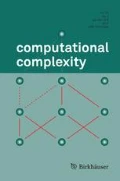Abstract
We show that strong-enough lower bounds on monotone arithmetic circuits or the nonnegative rank of a matrix imply unconditional lower bounds in arithmetic or Boolean circuit complexity. First, we show that if a polynomial \(f\in \mathbb {R}[x_1,\dots , x_n]\) of degree d has an arithmetic circuit of size s then \((x_1+\dots +x_n+1)^d+\epsilon f\) has a monotone arithmetic circuit of size \(O(sd^2+n\log n)\), for some \(\epsilon >0\). Second, if \(f:\{0,1\}^n\rightarrow \{0,1\}\) is a Boolean function, we associate with f an explicit exponential-size matrix M(f) such that the Boolean circuit size of f is at least \(\varOmega (\min _{\epsilon >0}(\mathrm{rk}_{+}(M(f)-\epsilon J))- 2n)\), where J is the all-ones matrix and \(\mathrm{rk}_{+}\) denotes the nonnegative rank of a matrix. In fact, the quantity \(\min _{\epsilon >0}(\mathrm{rk}_{+}(M(f)-\epsilon J))\) characterizes how hard is it to distinguish rejecting and accepting inputs of f by means of a linear program. Finally, we introduce a proof system resembling the monotone calculus of Atserias et al. (J Comput Syst Sci 65:626–638, 2002) and show that similar \(\epsilon \)-sensitive lower bounds on monotone arithmetic circuits imply lower bounds on proof-size in the system.
Similar content being viewed by others
References
A. Atserias, A. Dawar & J. Ochremiak (2019). On the power of symmetric linear programs. In 34th Annual ACM/IEEE Symposium on Logic in Computer Science (LICS)
Atserias, A., Galesi, N., Pudlák, P.: Monotone simulations of non-monotone proofs. J. of Computer and System Sciences 65, 626–638 (2002)
S. Basu, R. Pollack & M.F. Roy (2006). Algorithms in real algebraic geometry. Springer-Verlag.
Beasley, L., Laffey, T.: Real rank versus nonnegative rank. Linear Algebra and its Applications 431(12), 2330–2335 (2009)
G. Braun, S. Fiorini, S. Pokutta & D. Steuer (2012). Approximation Limits of Linear Programs (Beyond Hierarchies). In FOCS, 480–489
P. Bürgisser, M. Clausen & M. A. Shokrollahi (1997). Algebraic complexity theory, volume 315 of A series of comprehensive studies in mathematics. Springer
D. deCaen, D. Gregory & N. Pullman (1981). The Boolean rank of zero one matrices. In Proceedings of the Third Caribean Conference on Combinatorics and Computing, 169–173
Samuel Fiorini, Serge Massar, Sebastian Pokutta, Hans Raj Tiwary & Ronald de Wolf (2011). Linear vs. Semidefinite Extended Formulations: Exponential Separation and Strong Lower Bounds. CoRR arXiv:1111.0837
Goos, M., Jain, R., Watson, T.: Extension complexity of independent set polytopes. SIAM J. Comput. 47(1), 241–269 (2018)
Hrubeš, P.: On the nonnegative rank of distance matrices. Information Processing Letters 112(11), 457–461 (2012)
P. Hrubeš (2019). On the complexity of computing a random Boolean function over the reals. ECCC
Pavel Hrubeš & Amir Yehudayoff: Homogeneous formulas and symmetric polynomials. Computational Complexity 20(3), 559–578 (2011)
Krajíček, J.: Bounded arithmetic, propositional logic, and complexity theory. Cambridge University Press, USA (1995)
N. Nisan (1991). Lower bounds for non-commutative computation. In Proceeding of the 23th STOC, 410–418
P. Pudlák & M. de Oliveira Oliveira (2017). Representations of monotone Boolean functions by linear programs. In Proceedings of the 32nd Computational Complexity Conference
R. Raz (2004). Multi-linear formulas for Permanent and Determinant are of super-polynomial size. In Proceeding of the 36th STOC, 633–641
A. Razborov (1992). On submodular complexity measures. In Boolean functions complexity, 76–83. Cambridge University Press
T. Rothvoss (2017). The matching polytope has exponential extension complexity. J. of the ACM 64(6).
Thomas Rothvoß (2011). Some 0/1 polytopes need exponential size extended formulations. CoRR arXiv:1105.0036
Shamir, E., Snir, M.: On the depth complexity of formulas. Journal Theory of Computing Systems 13(1), 301–322 (1979)
Amir Shpilka & Avi Wigderson (1999). Depth-3 arithmetic formulae over fields of characteristic zero. In In CCC, 87. IEEE Computer Society
Amir Shpilka & Amir Yehudayoff: Arithmetic Circuits: A survey of recent results and open questions. Foundations and Trends in Theoretical Computer Science 5(3), 207–388 (2010)
L. G. Valiant (1979). Completeness Classes in Algebra. In STOC, 249–261
Valiant, L.G.: Negation can be exponentially powerful. Theoretical Computer Science 12, 303–314 (1980)
Valiant, L.G.: Reducibility by algebraic projections. Enseign. Math. 28, 253–268 (1982)
Valiant, L.G.: Negation is powerless for Boolean slice functions. SIAM J. Comput. 15(2), 531–535 (1986)
S. A. Vavasis (2008). On the complexity of nonnegative matrix factorization. SIAM Journal on Optimization 20(3), 1364-1377
I. Wegener (1987). The complexity of Boolean functions
Yannakakis, Mihalis: Expressing combinatorial optimization problems by linear programs. Journal of Computer and System Sciences 43(3), 441–466 (1991)
A. Yehudayoff (2019). Separating monotone VP and VNP. In STOC
Acknowledgements
We thank Pavel Pudla'k for inspiration and Amir Yehudayoff for, unwittingly, making the author to write the paper in the first place. Supported by the GACR grant 19-27871X.
Author information
Authors and Affiliations
Corresponding author
Additional information
Publisher’s Note
Springer Nature remains neutral with regard to jurisdictional claims in published maps and institutional affiliations.
Rights and permissions
About this article
Cite this article
Hrubeš, P. On \(\epsilon\)-sensitive monotone computations. comput. complex. 29, 6 (2020). https://doi.org/10.1007/s00037-020-00196-6
Received:
Published:
DOI: https://doi.org/10.1007/s00037-020-00196-6




